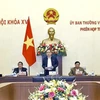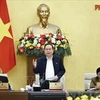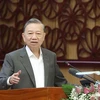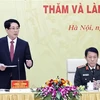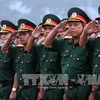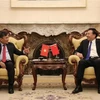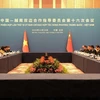The party’s political platform is a beacon of ideology and theory for the nation’s revolutionary cause, Politburo member Nguyen Phu Trong has affirmed.
Prof. Dr. Trong, who is also National Assembly Chairman, made the affirmation in his presentation delivered at a seminar titled “the Communist Party of Vietnam – 80 Years of Building and Development”, which was organised by the Ho Chi Minh National Political and Administrative Academy in Hanoi on Jan. 26.
In his presentation, Trong reviewed the four Political Platforms adopted by the Communist Party of Vietnam (CPV) since its inception in 1930. These included:
1. The Party’s Brief Political Platform compiled by Nguyen Ai Quoc (who later took the name Ho Chi Minh), which was discussed and adopted at the Party’s Founding Conference in February 1930.
After analysing the social situation in Vietnam in late 19th century and early 20th century, a time when the country was still dominated by the French colonialists and feudalists of the Nguyen Dynasty, the Political Platform set forth guidelines for the Vietnamese revolution -- “to carry out bourgeois, civil rights and land revolutions to advance toward a communist society”. In a broad sense, it referred to the launch of a national democratic revolution with the aim of establishing socialism and communism.
Apart from developing the Brief Political Platform, Nguyen Ai Quoc also compiled a Brief Policy, a Brief Programme, Brief Statutes, and an Appeal of the Party, all of which were passed by the Founding Party Conference. They have become important, classic documents for the Party, helping to define strategic guidelines and key policies for the Vietnamese revolution as well as work out guidelines, goals, and principles mandating the CPV’s organisation and activities.
2. The Political Thesis of the Indochinese Communist Party which was drafted by Party General Secretary Tran Phu, and discussed and approved at the Party Central Committee’s conference held in October 1930.
The Thesis pointed out that the goal of the bourgeois and civil rights revolution in Indochina was to overthrow colonialism and feudalism to bring a complete independence to Indochina . A worker-peasant government would be established to provide a solid basis for the revolution to succeed.
3. The Political Platform of the Labour Party of Vietnam, which was compiled under the instructions of President Ho Chi Minh and Party General Secretary Truong Chinh, and discussed and passed at the Party’s second Congress in February 1951.
This Political Platform set forth the goals for the Vietnamese revolution -- the fulfilment of the cause of national liberation, eradicating feudalism, developing a people’s democratic regime, and advancing toward socialism. It outlined a resistance policy to wage a comprehensive, long-term people’s war of resistance in order to bring independence and reunification to the fatherland. The Platform also underscored the need to build a people’s democratic administration based on an alliance of workers, peasants, and intellectuals under the leadership of the working class.
4. The Political Platform guiding national construction in a transitional phase to socialism (known as the 1991 Political Platform), which was discussed and passed at the Party’s VIIth Congress in June 1991.
This platform was compiled at a time when the Soviet Union and many socialist republics in Eastern Europe had collapsed, a chain of communist parties around the world had lost direction and become stagnant, and hostile forces were on the attack against communists. In the meantime, the country was suffering from a socio-economic crisis and confidence in the administration among a number of state officials, party members, and people was wavering.
The platform summed up the course of the Vietnamese revolution, drew from the lessons and experiences of the past, and laid out orientations and solutions to renew the country comprehensively on the path toward socialism.
It put forth the goal of building a socialist society, where the working people shall be the masters, with a highly-developed economy based on modern production forces and a public ownership mechanism applied to the main materials of production, as well as a culture deeply imbued with national identity, and where the people are free from suppression, exploitation and injustice, leading a prosperous, free and happy life.
According to the platform, Vietnam ’s transition to socialism would take a very long time and experience various stages of development. By the end of this transitional period, the country would have to achieve an overall goal of building fundamental socialist economic establishments with a developed cultural, ideological and political superstructure, thus turning the country into a prosperous socialist republic.
Reviewing the main contents of the CPV’s Political Platforms since 1930, Trong pointed out that though each political platform has had its own objectives, reflecting the situation and revolutionary objectives in each phase of its development, they have all reflected the same basic viewpoint and the consistent ideology of the Party on the aims, strategic tasks, orientations and methods of the Vietnamese revolution.
These viewpoints voice the need to fight for and firmly defend national independence and unification; build a more democratic and stronger country; develop a more just and civilised society; and ensure that the people enjoy a prosperous, free and happy life, according to Trong.
He stressed on the goal of national independence toward socialism, describing it as a “red thread” binding every stage of the Vietnamese revolution.
To apply these ideas in practice, Trong underlined the necessity to safeguard and maintain the Party’s leadership; build a pure Party in terms of politics, ideology and organisation on the basis of Marxism-Leninism, Ho Chi Minh’s Thoughts, and the principle of centralised democracy, in close conjunction with the people. He described these tasks as vital to the Party, and as key factors in every victory of the national revolution.
According to Trong, each Party Political Platform was developed on the basis of grasping thoroughly, applying creatively, supplementing and developing the basic stances of Marxism-Leninism, Ho Chi Minh’s Thoughts, and the nation’s traditional essence. They are correctly reflected realities in Vietnam and also drew from the experiences of other countries around the world.
Each Party Political Platform has had a special significance and great value in guiding the country’s development and remains a beacon for the Party and people to follow, said Trong.
By grasping thoroughly and adhering seriously to the Party’s Political Platforms and other important documents over the past 80 years, the Party has led the people through long and hard struggles, and overcome numerous difficulties and challenges to gain great victories in the end, he emphasised.
These triumphs have provided proof that the Party’s key guidelines and viewpoints have been correct and creative, that the Party’s Political Platforms have had great value and durable vitality, and that the country’s revolutionary path is in line with objective rules and meets the requirements of the reality in Vietnam, said Trong./.
Prof. Dr. Trong, who is also National Assembly Chairman, made the affirmation in his presentation delivered at a seminar titled “the Communist Party of Vietnam – 80 Years of Building and Development”, which was organised by the Ho Chi Minh National Political and Administrative Academy in Hanoi on Jan. 26.
In his presentation, Trong reviewed the four Political Platforms adopted by the Communist Party of Vietnam (CPV) since its inception in 1930. These included:
1. The Party’s Brief Political Platform compiled by Nguyen Ai Quoc (who later took the name Ho Chi Minh), which was discussed and adopted at the Party’s Founding Conference in February 1930.
After analysing the social situation in Vietnam in late 19th century and early 20th century, a time when the country was still dominated by the French colonialists and feudalists of the Nguyen Dynasty, the Political Platform set forth guidelines for the Vietnamese revolution -- “to carry out bourgeois, civil rights and land revolutions to advance toward a communist society”. In a broad sense, it referred to the launch of a national democratic revolution with the aim of establishing socialism and communism.
Apart from developing the Brief Political Platform, Nguyen Ai Quoc also compiled a Brief Policy, a Brief Programme, Brief Statutes, and an Appeal of the Party, all of which were passed by the Founding Party Conference. They have become important, classic documents for the Party, helping to define strategic guidelines and key policies for the Vietnamese revolution as well as work out guidelines, goals, and principles mandating the CPV’s organisation and activities.
2. The Political Thesis of the Indochinese Communist Party which was drafted by Party General Secretary Tran Phu, and discussed and approved at the Party Central Committee’s conference held in October 1930.
The Thesis pointed out that the goal of the bourgeois and civil rights revolution in Indochina was to overthrow colonialism and feudalism to bring a complete independence to Indochina . A worker-peasant government would be established to provide a solid basis for the revolution to succeed.
3. The Political Platform of the Labour Party of Vietnam, which was compiled under the instructions of President Ho Chi Minh and Party General Secretary Truong Chinh, and discussed and passed at the Party’s second Congress in February 1951.
This Political Platform set forth the goals for the Vietnamese revolution -- the fulfilment of the cause of national liberation, eradicating feudalism, developing a people’s democratic regime, and advancing toward socialism. It outlined a resistance policy to wage a comprehensive, long-term people’s war of resistance in order to bring independence and reunification to the fatherland. The Platform also underscored the need to build a people’s democratic administration based on an alliance of workers, peasants, and intellectuals under the leadership of the working class.
4. The Political Platform guiding national construction in a transitional phase to socialism (known as the 1991 Political Platform), which was discussed and passed at the Party’s VIIth Congress in June 1991.
This platform was compiled at a time when the Soviet Union and many socialist republics in Eastern Europe had collapsed, a chain of communist parties around the world had lost direction and become stagnant, and hostile forces were on the attack against communists. In the meantime, the country was suffering from a socio-economic crisis and confidence in the administration among a number of state officials, party members, and people was wavering.
The platform summed up the course of the Vietnamese revolution, drew from the lessons and experiences of the past, and laid out orientations and solutions to renew the country comprehensively on the path toward socialism.
It put forth the goal of building a socialist society, where the working people shall be the masters, with a highly-developed economy based on modern production forces and a public ownership mechanism applied to the main materials of production, as well as a culture deeply imbued with national identity, and where the people are free from suppression, exploitation and injustice, leading a prosperous, free and happy life.
According to the platform, Vietnam ’s transition to socialism would take a very long time and experience various stages of development. By the end of this transitional period, the country would have to achieve an overall goal of building fundamental socialist economic establishments with a developed cultural, ideological and political superstructure, thus turning the country into a prosperous socialist republic.
Reviewing the main contents of the CPV’s Political Platforms since 1930, Trong pointed out that though each political platform has had its own objectives, reflecting the situation and revolutionary objectives in each phase of its development, they have all reflected the same basic viewpoint and the consistent ideology of the Party on the aims, strategic tasks, orientations and methods of the Vietnamese revolution.
These viewpoints voice the need to fight for and firmly defend national independence and unification; build a more democratic and stronger country; develop a more just and civilised society; and ensure that the people enjoy a prosperous, free and happy life, according to Trong.
He stressed on the goal of national independence toward socialism, describing it as a “red thread” binding every stage of the Vietnamese revolution.
To apply these ideas in practice, Trong underlined the necessity to safeguard and maintain the Party’s leadership; build a pure Party in terms of politics, ideology and organisation on the basis of Marxism-Leninism, Ho Chi Minh’s Thoughts, and the principle of centralised democracy, in close conjunction with the people. He described these tasks as vital to the Party, and as key factors in every victory of the national revolution.
According to Trong, each Party Political Platform was developed on the basis of grasping thoroughly, applying creatively, supplementing and developing the basic stances of Marxism-Leninism, Ho Chi Minh’s Thoughts, and the nation’s traditional essence. They are correctly reflected realities in Vietnam and also drew from the experiences of other countries around the world.
Each Party Political Platform has had a special significance and great value in guiding the country’s development and remains a beacon for the Party and people to follow, said Trong.
By grasping thoroughly and adhering seriously to the Party’s Political Platforms and other important documents over the past 80 years, the Party has led the people through long and hard struggles, and overcome numerous difficulties and challenges to gain great victories in the end, he emphasised.
These triumphs have provided proof that the Party’s key guidelines and viewpoints have been correct and creative, that the Party’s Political Platforms have had great value and durable vitality, and that the country’s revolutionary path is in line with objective rules and meets the requirements of the reality in Vietnam, said Trong./.

